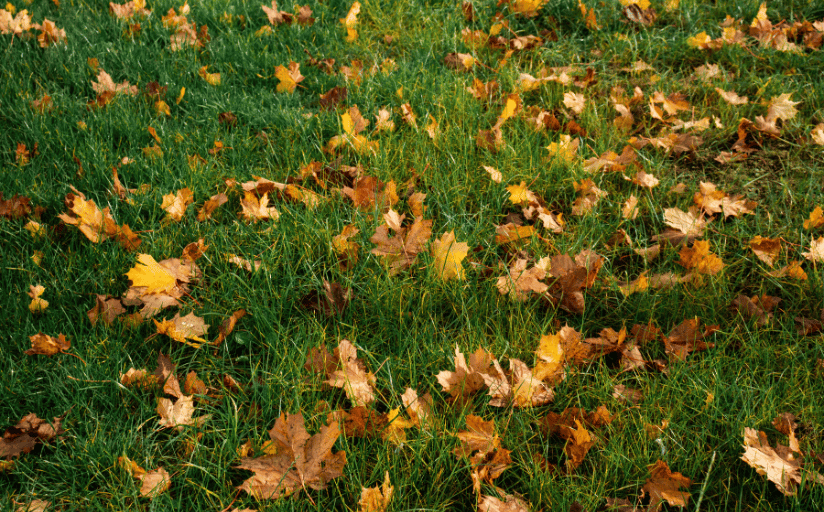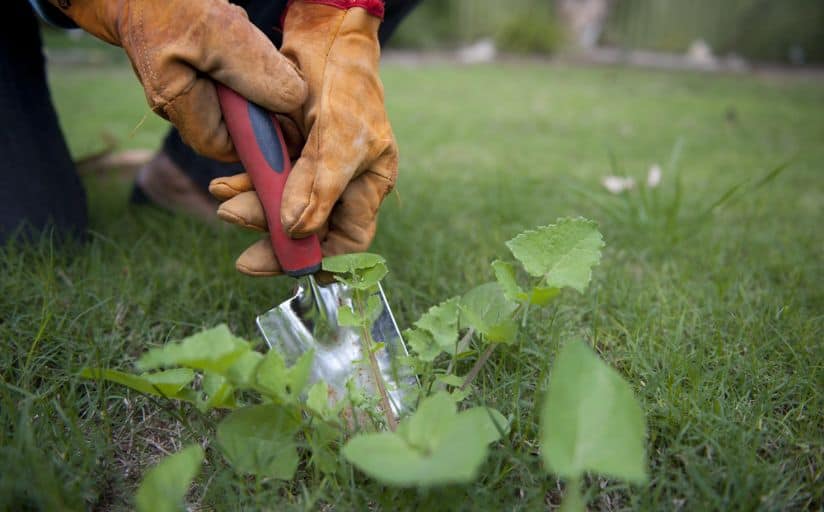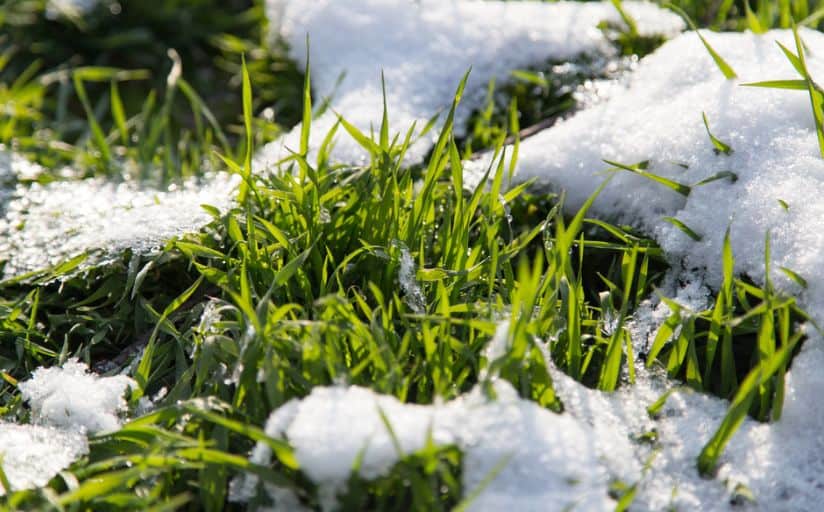Winter weather can take a real toll on your lawn, and you don’t want to face a patchy, lifeless yard once the snow melts. But how do you winterize a lawn? You prepare now so your grass bounces back strong when spring arrives. Taking a few simple steps protects your lawn from harsh temperatures, prevents damage, and saves you work (and worry) down the road. Learn how to protect your lawn from winter so your yard thrives, even when the frost hits.
(If you make a purchase using the links in this post, we may earn a commission.)
How To Prepare Your Lawn for Winter
Winterizing your lawn begins with solid fall prep. Here’s how you can get your grass ready to withstand the cold.
Aerate Your Yard
Aerating your lawn is one of the best things you can do to prepare it for winter. Over time, soil can become compacted from foot traffic, mowing, and even heavy rain, making it harder for water, air, and nutrients to reach the grass roots. Aeration solves this by creating small holes in the soil that give roots the room they need to grow deeper and stronger.
Fall is the ideal time to aerate because your grass is still actively growing and has time to recover before winter dormancy. Aerating also helps reduce thatch—a layer of dead grass and roots—that can block sunlight and trap moisture, leading to diseases.
Whether you use a plug aerator or a spike aerator, pair aeration with overseeding and fertilization. The loose soil makes it easier for seeds to take root and for nutrients to sink in, giving your lawn everything it needs for a healthy start when the snow melts. If you love your lawn, aerating is a must!
Adjust Your Mowing Height
Winterizing your lawn means trimming it correctly. Start lowering your mower deck by about half an inch with each mow as temperatures drop. For the last mow of the season, aim to keep your grass around 2–3 inches for cool-season grasses and 1.5–2 inches for warm-season varieties. Avoid cutting more than a third of the blade at once to reduce stress on the grass. And don’t forget to sharpen your mower blades—dull blades leave ragged edges that invite disease.

Remove Leaves and Debris
Picking up fallen leaves and debris on your lawn can help the grass stay healthy through the colder months. It also keeps snow mold and moss from taking over. Moss loves damp, shady spots where it doesn’t have to compete for light, and it can spread fast, stealing nutrients from your grass. So keeping your lawn clear not only helps it stay healthy during the winter but also sets it up to grow faster and thicker in the spring.
Fertilize in the Fall
In the fall, it’s a good idea to apply a high-nitrogen fertilizer to help your lawn get ready for winter. This fall nitrogen blitz helps strengthen the roots and store nutrients so your grass can survive the cold and bounce back in the spring.
Look for a fertilizer with at least 20% nitrogen—but more is even better to improve grass growth. For example, urea nitrogen typically has 46% nitrogen, which makes it super effective (and cost-efficient!) for a quick green-up and strong recovery.
BUY – Cz Garden Supply Urea Fertilizer 46-0-0
Ammonium sulfate is another good choice because it releases nitrogen quickly and also adds sulfur, which improves soil pH and still gives the lawn a deep green color with 21% nitrogen.
BUY – Greenway Biotech Ammonium Sulfate 21-0-0 Fertilizer
You could also look for a specialized “winter fertilizer” or “winterizer” that has higher potassium (the last number in the N-P-K ratio). Potassium boosts cold tolerance and helps plant cells resist disease. A ratio with moderate nitrogen and higher potassium (for example, 8-0-24 or 12-4-24) usually works really well.
BUY – Jonathan Green Winter Survival Fall Lawn Food (10-0-20)
Overseed Thin Areas
Overseeding thickens your lawn by adding new grass seeds where it’s thin or patchy. A denser lawn resists weeds, retains warmth better, and recovers faster from winter stress. Just make sure you choose a grass type that’s suited to your region for best results.
For example, if you live in a cooler climate, tall fescue or Kentucky bluegrass often work well. In warmer regions, Bermuda grass or centipede grass may be good choices. If you’re not sure what grass to use, ask a local garden center for guidance on the best seed mix in your area.

Remove Weeds
Weeding is an important part of winterizing your lawn. Left unchecked, weeds steal water, nutrients, and sunlight that your grass needs to thrive. Winter winds also spread weed seeds, leading to bigger problems when spring arrives.
Start by spotting common culprits, like dandelions or clover. Pull them by hand, or use a selective herbicide (like Roundup for Lawns) that goes after weeds without harming your grass. Fall is a smart time for weeding because cooler temperatures slow weed growth, and removing them now keeps them from taking over during winter dormancy.
A weed-free lawn not only looks cleaner but also has the resources to stay strong through winter. By making weeding part of your winter prep, you set your lawn up to bounce back healthier when the snow melts.
Prune Trees and Shrubs
Pruning your trees and shrubs before winter isn’t just about tidying up—it helps your entire yard get what it needs to thrive. Too often, people focus on mowing and fertilizing when winterizing their lawn, but they forget that overgrown branches can block the sunlight your grass needs to store energy and grow stronger roots in fall. By trimming back those branches, you allow more sunlight to reach the lawn right when it’s preparing for dormancy, giving it a better shot at bouncing back in spring.
Pruning also helps prevent branches from snapping under heavy snow or ice, which can damage your lawn and create more cleanup later. Keep an eye on any shrubs or tree limbs that look overgrown, and snip them back while the weather is still mild. It’s a simple step that often goes overlooked, but it makes a big difference for a healthier lawn come spring.
When Should You Winterize Your Lawn?
When prepping your lawn for winter, the timing will depend on the type of grass you have and the climate in your region. For cool-season grasses, such as Kentucky bluegrass and fescue, start your preparation in early to mid-fall. Aim to completely winterize your lawn about 6 to 10 weeks before the first expected frost. This gives your grass a chance to grow strong roots and store energy before entering its dormant phase.
For warm-season grasses, such as Bermuda or zoysia, the timeline shifts earlier. Begin your winter prep in late summer or early fall, and try to wrap up everything by early September.

What Are the Benefits of Winterizing Your Lawn?
Winterizing does more than keep your lawn alive through cold weather. It sets you up for a greener, healthier yard in spring.
- Health and Strength: A properly winterized lawn stands up better to frost and bounces back faster when temperatures rise.
- Disease Prevention: Winterizing wards off common cold-weather diseases like snow mold and fungus by keeping your lawn strong and well-fed.
- Weed Control: A thick, healthy lawn leaves no room for weeds to take root. Overseeding and proper fertilization help crowd out unwelcome growth.
Winterizing also ensures your lawn stays attractive, even in harsh winter.
Winterize Your Lawn and Enjoy a Greener Spring
Winterizing your lawn is more than just a seasonal chore—it’s about giving your grass the best chance to survive and thrive. By taking the time to learn how to prepare your lawn for winter, you can protect it from the stress of cold weather and set it up for a strong comeback in the spring. Think of it as a little TLC that rewards you with a thick carpet of green grass when the snow melts. So, grab your rake, your fertilizer, and maybe even your mower—it’s time to show your lawn some love before winter settles in!

